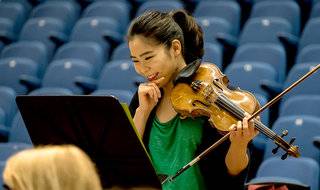|
Back
Plato and the Peak New York
Isaac Stern Auditorium, Carnegie Hall
02/08/2024 - & February 10*, 11, 13, 2024
Leonard Bernstein: Serenade (after Plato’s “Symposium”)
Richard Strauss: An Alpine Symphony, Op.64
Esther Yoo (Violin)
New York Philharmonic Orchestra, Santtu-Matias Rouvali (Conductor)

E. Yoo(© Courtesy of the Artist)
“What a poor appearance the tales of poets make when stripped of the colours which music puts upon them, and recited in simple prose.”
Plato
“Music, because of its specific and far-reaching metaphorical powers, can name the unnamable and communicate the unknowable.”
Leonard Bernstein
A few moments after Esther Yoo finished her so sensitive performance of Leonard Bernstein’s rare Serenade, I knew exactly why the film Maestro was such an abomination.
Serenade has the improbable orchestration of Plato’s Symposium. So one must wonder how he did it, why he did it, from whence cometh the inspiration. Two hour longMaestro never suggests, implies, recognizes, insinuates or even hints that Leonard Bernstein was a supremely eclectic composer, an inspired pianist, America’s most famous teacher, and–only in that clever verisimilitude of leading the Mahler 2nd finale–do we see a Madame Tussaud image (with that famed controversial Jewish nose) of the finished conductor.
Why did Serenade inspire such heretical thoughts? Simply because nowhere in Maestro–or in other places–was Bernstein granted the chuzpah for creating such an event.
The five movements depicted the four speakers of Plato’s drinking party–plus a group of drunken party-crashers for a jazzy finale. Yet following that would have been a losing cause. Instead, Bernstein, using only soloist, strings, harp and percussion to depict the “philosophical” stories of love, gave a most lovely work.
This was not a concerto. Ms. Yoo had no real cadenzas, her most emotional moments were twinned by the orchestra. Her part was difficult, with masses of double-stringing. Yet not once was her solo loud or showy. She was depicting the Bernstein version of Plato’s wordy social gathering, and it worked.
I would imagine that its first player, Isaac Stern, would have led a more bravura performance, and this might have quite caught the spontaneous mood of the Symposium reality. Ms. Yoo was more deliberate, she offered color when needed (especially with an exquisite first-movement duet with tubular bells). Yet this unalloyed virtuoso, with the Philharmonic and the mesmeric Finnish conductor Santtu‑Matias Rouvali were both collaborators and support.
After such an atmospheric 30 minutes, I didn’t really want a splashy encore. But Ms. Yoo gave such an irresistible solo of Henri Vieuxtemps’ variations on Yankee Doodle... well, she was happily forgiven. And the audience predictably gave greater cheers than for the more introspective Symposium.

S.-M. Rouvali (© Marco Borggreve)
If any conductor had to choose the opposite to Symposium, he couldn’t have chosen a more appropriate set of fireworks than Richard Strauss’ Alpine Symphony. Confessedly the first two times I heard it, I became suitably emotional with the beginning, with the trudging up an Alpine mountain, with the glorious triumph on the crest, and even the rainstorm (where Strauss cheated by using a wind machine).
Several hearings later, I became obsessed with the original orchestration, the masses of brasses, the thundering drums, the strings.
After this, Alpine Symphony lost its glamor. At first, it resembled those kitschy 19th Century swampy, forested German nature paintings. But there was something even more dire, which I heard last night.
Don’t misunderstand. Conductor Santtu-Matias Rouvali did a masterful job with the score. Admittedly, a conductor for such a complex use of the orchestra must be a traffic cop trying to sort out a traffic jam. But he still made the climaxes resound, and the relatively quiet sections hang together.
But this time, the Alpine Symphony image changed from moody German art to–wait for it–a Balinese painting. In those paintings, not a single inch is un‑painted. The canvas is filled with figures from top to bottom, the way Alpine Symphony is filled with horns (eight of them), trumpets and the whole Gargantuan orchestra blaring away with hardly an inch for rest.
Only one mountain has this writer climbed to the peak (Kilimanjaro), and the overlying, underlying only sound that last day was silence.
That, though, one couldn’t expect with Richard Strauss. Instead, when it was over I found my own Alpine symphony. Lin Bai’s 8th Century quiet quatrain:
“The birds have vanished down the sky/Now the last cloud drains away./We sit together, the mountain and me./Until only the mountain remains.”
Harry Rolnick
|